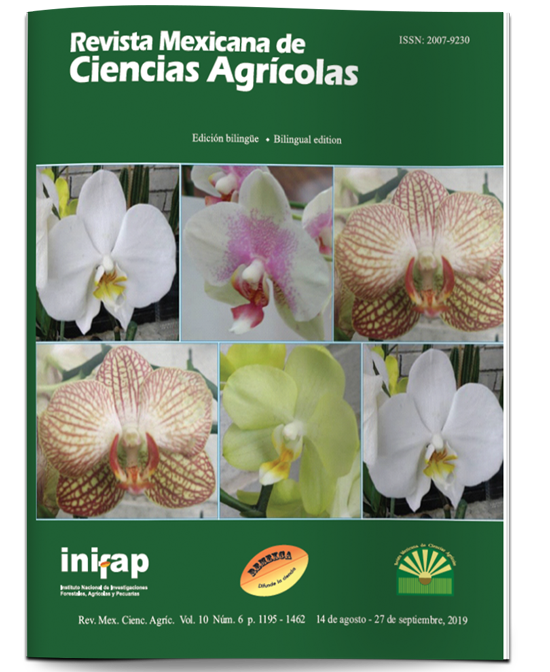Agronomic yield of tomato supplemented with Fe, Cu and Zn microelements
DOI:
https://doi.org/10.29312/remexca.v10i6.1822Keywords:
copper, iron, micronutrients, nutrient solution, zincAbstract
The tomato is one of the most important vegetables worldwide, so knowing the management of nutrition and its interaction in agronomic performance is important. The experiment was carried out in a low-tech greenhouse, of the Autonomous Agrarian University Antonio Narro with the objective of determining the supplementary effect in different concentrations of the Fe, Cu and Zn microelements on the agronomic yield of the tomato crop. Three factors were evaluated that consisted of the supplementary applications of fertilizers based on Fe, Cu and Zn and two levels of concentration for each case, in addition to the control treatment (normal dose of the Steiner nutrient solution). The treatments were evaluated by a completely randomized design with 3 x 2 factorial arrangement, with 16 repetitions per treatment. The low doses of Zn exceeded the control 27.3% in the variable vitamin C, while, in the total soluble solids, leaf area (AF), leaf area ratio (RAF) and specific leaf area (AFE) the high levels of Fe exceeded to the control in 16.4%, 138%, 112% and 44%, respectively; however, in yield the high doses of Cu exceeded the control 36%.
Downloads
Downloads
Published
How to Cite
Issue
Section
License
The authors who publish in Revista Mexicana de Ciencias Agrícolas accept the following conditions:
In accordance with copyright laws, Revista Mexicana de Ciencias Agrícolas recognizes and respects the authors’ moral right and ownership of property rights which will be transferred to the journal for dissemination in open access. Invariably, all the authors have to sign a letter of transfer of property rights and of originality of the article to Instituto Nacional de Investigaciones Forestales, Agrícolas y Pecuarias (INIFAP) [National Institute of Forestry, Agricultural and Livestock Research]. The author(s) must pay a fee for the reception of articles before proceeding to editorial review.
All the texts published by Revista Mexicana de Ciencias Agrícolas —with no exception— are distributed under a Creative Commons License Attribution-NonCommercial 4.0 International (CC BY-NC 4.0), which allows third parties to use the publication as long as the work’s authorship and its first publication in this journal are mentioned.
The author(s) can enter into independent and additional contractual agreements for the nonexclusive distribution of the version of the article published in Revista Mexicana de Ciencias Agrícolas (for example include it into an institutional repository or publish it in a book) as long as it is clearly and explicitly indicated that the work was published for the first time in Revista Mexicana de Ciencias Agrícolas.
For all the above, the authors shall send the Letter-transfer of Property Rights for the first publication duly filled in and signed by the author(s). This form must be sent as a PDF file to: revista_atm@yahoo.com.mx; cienciasagricola@inifap.gob.mx; remexca2017@gmail.
This work is licensed under a Creative Commons Attribution-Noncommercial 4.0 International license.



